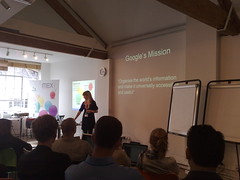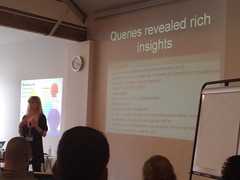Links
May 22, 2009 | Comments- Moblin, a project the esteemed Mr Richards has been beavering away on, is launched - looking extremely tasty, particularly for a 1.0 ...
- The Big Lunch, a nationwide social eating project. None near us... yet. Any takers?
- Groundhog day for NFC: "it could all work really well if we viewed mobile phone apps a bit more like ring tones and made them as easy to obtain and dispose of"
- Mobile literacy, an Adaptive Path research project in rural India;
- Software development advice for startups: "Software development is complicated, expensive, error-prone, regularly boring and complicated. As a programmer, here’s what I think you should know before we meet for coffee"
- The clean sheet of paper: "two ways to work with talent"
- Frank Lloyd Lego sets, beautiful.
- Equally beautiful in another way, SickCity - realtime disease collection.
- The design with intent toolkit, "features 12 design patterns which recur across design fields (interaction, products, architecture), and there are also 35 more detailed here on the website. Some of the names will be unfamiliar, but we hope the patterns and examples will be understandable, and inspire your own concepts."
MEX: The Delicate Path of Balancing Commercial Imperative and User Experience, Priya Prakash
May 19, 2009 | CommentsMEX: The Delicate Path of Balancing Commercial Imperative and User Experience, Priya Prakash
Priya's moved from Flirtomatic to Icon to Nokia.
Balancing commercial imperatives with user experience is a bit like "Man on Wire": it's tough but if you do it right, there's a beauty to it.
What is value, as perceived by the customer?
References the $999 "I Am Rich" app. 3 days of fame on the app store led to $5300 dollars.
I hang out on customer forums when I don't have time to talk to real people: found someone wanted to transfer old text messages from an old iPhone to a new one. No matter how interesting the GUI is, there's sentimentality here.
Orange Wednesdays: long-running promotion, clearly defined benefits, touches on brand value (bringing people together to share an experience).
Shows iPhone, Prada Phone, Blackberry: each has a perceived value, different audience. Not everyone goes for the iPhone.
Traditionally marketing pushes for more functions, linking more functions to more value. But we know people use small %age of functions on phones.
Value is perceived based on the story you create in the mind of the customer.
Shows 2008 CRM planner for Flirtomatic. Every week Priya sat with her team to come up with new promotions and campaigns. Talks about leap year proposal day. Talks about flirt point currency, encouraging sleeping flirters to wake up.
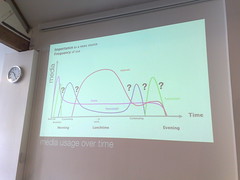 Can a paid-for service enhance the users' perception of the experience?
Can a paid-for service enhance the users' perception of the experience?
Where and when are value exchanges happening?
In Flirtomatic the biggest call to action was "I'm bored". Don't make registration a barrier to entry. What are the hooks motivating people to come back?
Compare to Sky+, radio, daily newspaper and Guardian web site. You can consume the same news through all of then. Radio feels free but is prepaid via license fee; web site is ad-funded; paper is paid-for and ad-funded; Sky+ shows it.
Shows graph of media consumption throughout the day. Shows graph of mobile vs PC usage of Flirtomatic per day.
Shows table-data-porn from Flirtomatic.
Talks about time spent running Digital Wellbeing at Bluebird: things need to change in retail world to keep folks engaged and involved.
Will distraction-based advertising ever work in mobile?
There is little value in it unless you're stationary.
Flirtomatic had more revenue from user-to-user ads than third party ads. There's a bidding process for ads, they're time-limited... a bit like advertorial.
What revenue models provide the best experience?
Skype credit automatically recharges itself. There's no repeat-entry of credit card details. It's seamless. Maybe only 8% of the people are propping up the rest of it, that's fine.
Ars Technica article on the Zune Pass: it's costs $30,000 to fill an iPod, ZunePass is a subscription model for music.
Shows the Flrtomatic Freemium Funnel - taking users from registration to revenue-generating.
On iPhone, engagement for paid apps is more than for free apps.
The App Store needs curation to help people discover apps, just like physical shops do.
What is customer reality?
People snack.
People never upgrade unless the free version doesn't deliver core benefits.
People don't register.
People use other peoples accounts.
People hesitate to give CC details on per-use basis.
People like frivolity.
People are bored or busy.
So to monitise, you need a highly reactive business strategy. It's like the fashion industry - look at Zara - you need to be flexible and timely to react to market needs.
Q: Re phones baffling users: one related article said that smartphones are driving the mobile market. If more people are buying them but everyone is saying they're confusing... where's the disconnect?
A: People want them, but can't use them.
Q: Industry has thought of functions as physical things for too long. We've spent a lot of time building swiss army knives and albatrosses.
A: There's been an underappreciation for frivolity too. It's not a question of more functions being bad, it's about communicating value to users and looking at the discovery process.
MEX: Sian Townsend, Google
May 19, 2009 | CommentsGoing to talk about 5 elements of a successful emerging market strategy. Personal views, with examples from Google.
What happens when you hand someone a mobile and say "you can ask a question and get an answer"?
In East Africa...
Want to know how ebola is spread. If HIV can be cured. What drug is best for malaria. How to stop vines wilting. Whether panadol effects outcome of an HIV test. Why tomatoes wilt. Why feet smell.
Local solutions to local problems.
Sian is a user experience researcher at Google, focused on mobile search, internationally. Background in HCI and development politics.
1. Don't presume you know the answers.
Search has been rolled out in African languages and by SMS. "Suggest in Swahili" was launched last week, getting around problems with user input.
2. Collaborate
G mapped lots of African countries that hadn't been mapped at all. Where we don't have data we encourage others to contribute. We allow users to create maps themselves. Local users can annotate areas and contribute data really well.
With search, we have "Google in your language" - 38 languages translated by locals.
3. Take a long term view
Google works with universities to nurture cutting edge research; runs competitions to challenge students and understand what kind of content appetites new users in the domain have - letting them show us the way forward.
Invested in infrastructure, improving connectivity. Google.org is another avenue for them to get involved. A broad strategy; "a rising tide lifts all boats"
Research from Uganda. Localising your own product may be missing the point - you might benefit from doing something new, and strategic user research is the way to find out if this is the case.
Right now, most Google searches are W. Europe and N. America. Mobile will be the future; but it's messy and not a simple case of "just moving everything over". In Africa, designing mobile products is tough: simple devices, few data plans, widespread prepay. There's v little digital content - even with fantastic connectivity, what will you search for in your local language if nothing's digitised?
Research project in E Africa: 4 weeks ethnographic research by an academic, focus groups showing 20 concepts through a network of village phone operators, and a Wizard of Oz experiment (where you don't know if you're talking to a human or a machine). A social impact assessment ran alongside all of these to ensure we were being socially responsible.
Wizard of Oz experiment was about exploring local content appetites, collecting data quickly and evaluating mobile as a channel. Set up a control centre, trained 12 field researchers to go out into the field: 17 locations, let end-users ask questions. They used Frontline SMS and a GSM Modem to gather messages and respond to health questions.
Queries revealed rich insights. Multi-linguistic teams were used to ensure questions were asked in a language the asker was comfortable using. Manually matched up conversations to do analysis (quantitative data), they mapped the research data into user journeys to get qualitative data.
Built prototypes off the back of this, going into product pilots. Tested, learned, iterated - particularly important for SMS products where you have to spend a lot of time analysing logs to look for synonyms etc.
They will be launching a suite of products off the back of this research.
5. Embrace local ingenuity
With the best intentions, designs done by outsiders can be subverted - this is OK and is one of the exciting things about emerging markets. Some villages, for instance, don't have a local phone - enterprising businessfolks buy a phone and drive it around these villages in a bike.
Shows an "analog blogger" - guy who has a network of news reporters. He writes it on a chalk board and has customers come and view it. He runs advertising on the board :)
Q: How did literacy play a part in your studies? Were maps the way that people represented space in African cultures?
A: The only way to discover this is by giving someone a phone. Government statistics aren't as reliable as seeing what people want to do and how they do it. On maps: don't know, I'm focused on search. My guess would be that lots of people use other representations.
MEX: Mobile Mandate, Robert, Frog Design
May 19, 2009 | CommentsMEX: Mobile Mandate, Robert, Frog Design
We've been collectively frustrated by the gap between aspirations and reality. What are the most meaningful things that we can touch with the device - areas like healthcare, education?
Robert tells a story about Zinny (sp?) - AIDS sufferer admitted to hospital, one of the first few to be put on an ARV programmer who recovered. She started an organisation with a Harvard-trained doctor to run a treatment and education programme in S. Africa.
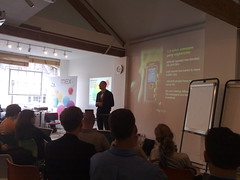 Talks about ARV projects which are complex to manage - information and help is needed to manage tests and treatment, and they're falling behind. Most people come in for tests when they're already in a poor condition: low survival rate, difficulty in completing any ARV programme.
Talks about ARV projects which are complex to manage - information and help is needed to manage tests and treatment, and they're falling behind. Most people come in for tests when they're already in a poor condition: low survival rate, difficulty in completing any ARV programme.
The system right now doesn't work for them. They need to reach more people - not the 120k folks they're working with now, but the 40% of the population of the local area at risk.
They get leverage through mobile technologies. How can they use mobile to reach out, get people to test, and encourage them to stick with treatment?
Launched 2008 with a mobile outreach campaign. 80-90% of S.Africa have access to a mobile, 90% prepay. They have an SMS-like service, 6 free messages/day when you run out of minutes that let you send a v short message for a phone number: the message being "please call me". There's a bit of spare space in these messages. They got the second-largest operator to donate 5% of its inventory of this space (priced at $250,000 p.a. - not bad for reaching a million people a day). That's a million messages containing worthwhile AIDS/HIV information, "the worlds biggest field trial of mobile health technology".
Wow.
This is the *only* way to reach these people. Next step: testing and ongoing support.
There's a huge revolution in low-cost diagnostics. The kits are routinely stolen and cost $18 apiece - there's a huge demand for them.
Mobile is not one channel, it's many. What about voicemail - 90s of audio delivered into mailboxes for free, e.g. a message from Nelson Mandela encouraging them to test. You need a model that brings these today (this sounds like the "seams" topic we covered at Future of Mobile last year).
Instructions on the kits are paired with numbers you can call for support at each step. How do we keep people aware throughout? With various calls to action. A local record label had its stars endorse and get tested at the hospital - ensuring this was seen as a locally supported campaign. They user-tested instructions on young men getting HIV tested for the first time.
Frogs US clients are desperately interested in this too - getting people to actively engage with healthcare.
What's missing? Good design. People need feedback. It's not about haptic feedback and rich media. We need partnerships - with Nokia, Nike, anyone with vested interests in these markets.
Frog is committing to one catalyst project per year in mobile health. Currently considering: depression/mood support, social willpower, counterfeit drugs.
MEX, Customer Research Methodology Must Be Enhanced To Close The Reality Gap: Rachel Hinman, Adaptive Path
May 19, 2009 | CommentsMEX, Failures of Imagination: The Role of Research in Mobile User Experience: Rachel Hinman, Adaptive Path
References an analogy between economic crisis, blamed on a failure of imagination amongst economists and policy-makers. User research isn't naturally associated with imagination either, it's seen as being about hard data.
But user research is often used to validate existing ideas: "tell me I'm right". Hypothesis vs agenda - a hypothesis opens up possibilities, an agenda leads to an attempt for proof.
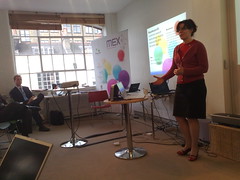 Mobile devices are "frankenstein technology", difficult for people to use. But mobile represents "an opportunity to invent new ways for users to interact with information". Mobile devices are a tangible way to explore these new ways, as opposed to intangible ubicomp stuff. But we need to acknowledge our agendas when coming to this stuff - and be more explorative.
Mobile devices are "frankenstein technology", difficult for people to use. But mobile represents "an opportunity to invent new ways for users to interact with information". Mobile devices are a tangible way to explore these new ways, as opposed to intangible ubicomp stuff. But we need to acknowledge our agendas when coming to this stuff - and be more explorative.
Rachel's presenting three examples:
Expert Interviews, for a handset vendor looking at future of UI 3-5 years out. They didn't want to talk to mobile industry experts, but people at the periphery of mobile - those connected to it but with some other specialism. e.g. Bruce Sterling, Adam Greenfield (talking about mobile devices as wands, helping us choreograph our interactions with the world). The wand metaphor comes up again and again.
Took everyday objects (e.g. magnifying glass) out into the street and pretended they were mobile devices. Pipe-like devices lead to metaphors about pouring data (reminds me of the Siftables presentation).
Deprivation Study from 2007 - about accessing internet content on a mobile. Shows video of users talking about accessing content mobile-ly; they note that mobile is different and might need different, tailored UI. Quoth one: "It's called surfing for a reason - it's about a flow".
Design principles arising from this research: craft mobile interfaces that speak their power (i.e. use affordances to build intuition); dismantle the page metaphor (which is brittle: if web pages are boulders, mobile elements are pebbles); and cope with partial attention.
Decrypting Context; it's hard to grok because it's complex. How do you design for anything and anywhere? "It's about understanding human relationships to people, places and things in the world". Relationships are semantic (based around shared meaning), social, spatial or temporal. These relationships rarely occur in isolation.
Example: peanut butter has a spatial relationship (it's in a cupboard at home, or in a certain place in the store); a temporal one (probably have it on toast in the morning); a social one (she's on the Flickr stream for it and has heated arguments with friends about it); and a semantic one (when visiting Japan she'd need to know the word for it and would have to pantomime it).
How can a mobile help Rachel get peanut butter in Denver, NOW?
Mobile is better than a PC for spatial or temporal relationships because you can physically move it to relate to the world... and because it's available to a greater degree.
See also Adaptive Path on Mobile Literacy and Rachel's slides on SlideShare.
Q: There's a lot of research on how usage patterns differ by age. Aren't children closer to the future than we are?
A: I think Africa is probably nearer. If someone's carrying a baby and their phone, this shifts social structures. It's not about technology and device, but how it's shaping how people do stuff.
Q: Intrigued by wand analogy. Harry Potter had some usability issues!
A: Adam and Bruce both said they liked the idea it evoked, but the challenge was that there's a mystery element to it, a sense of uncontrolled sorcery, which may not be something you want to put out for users. A conductors wand is probably a better metaphor.
